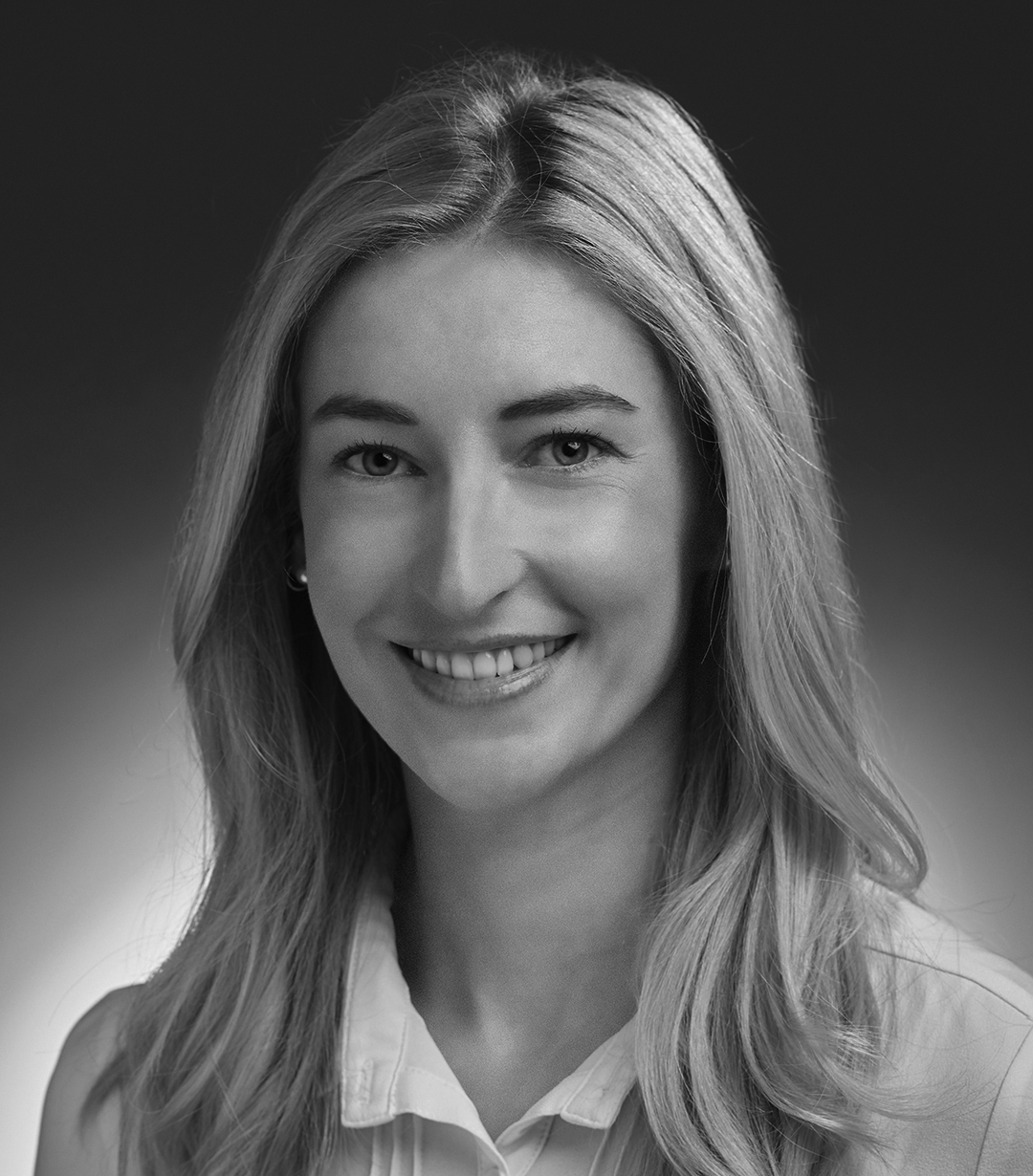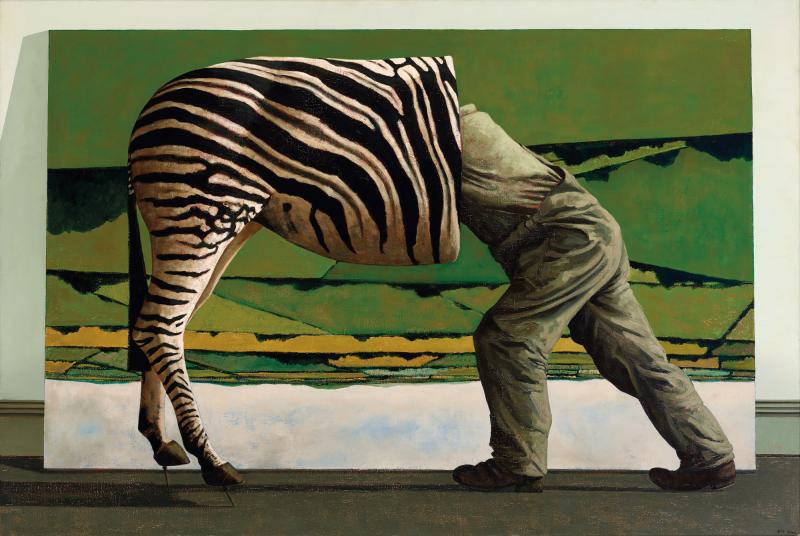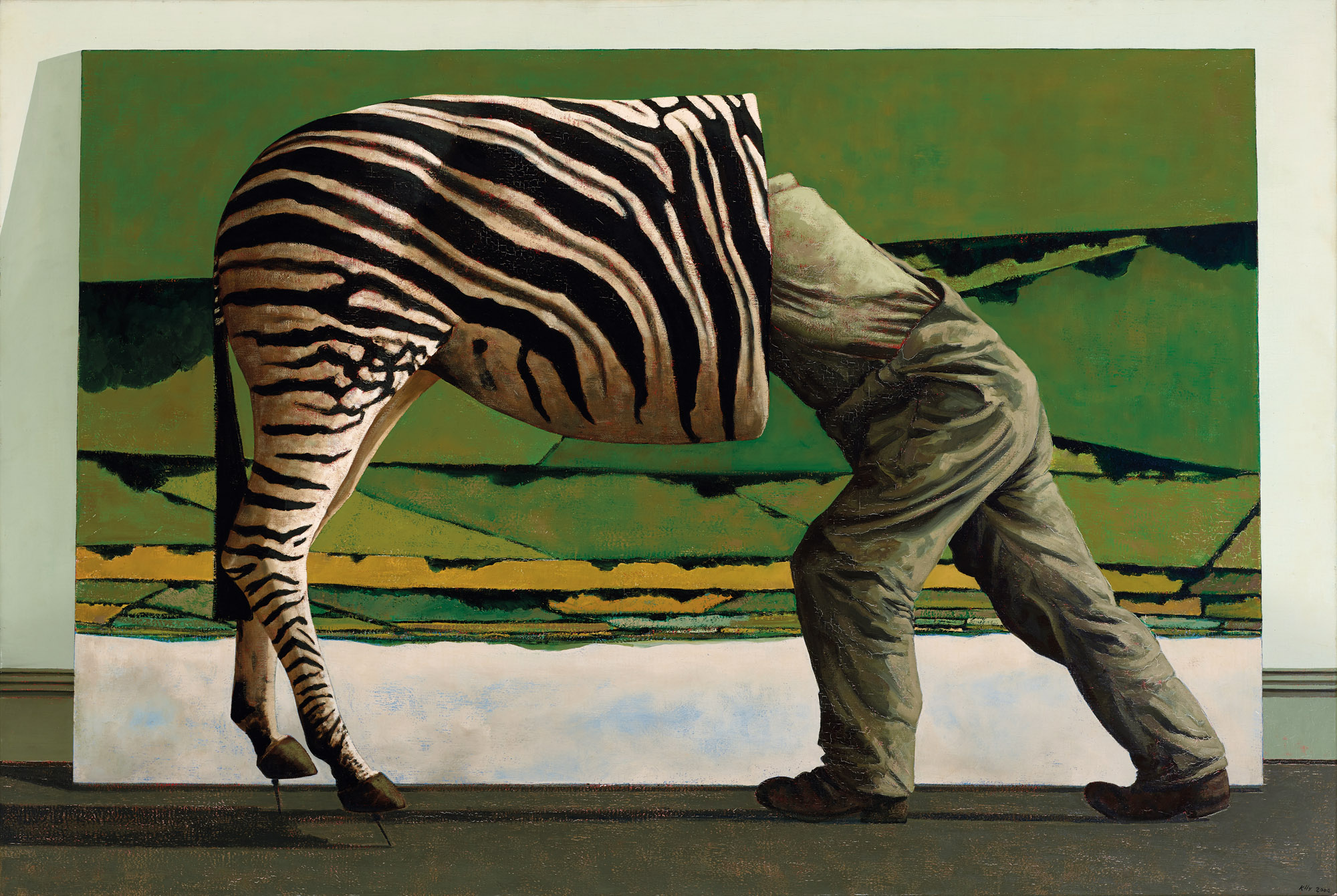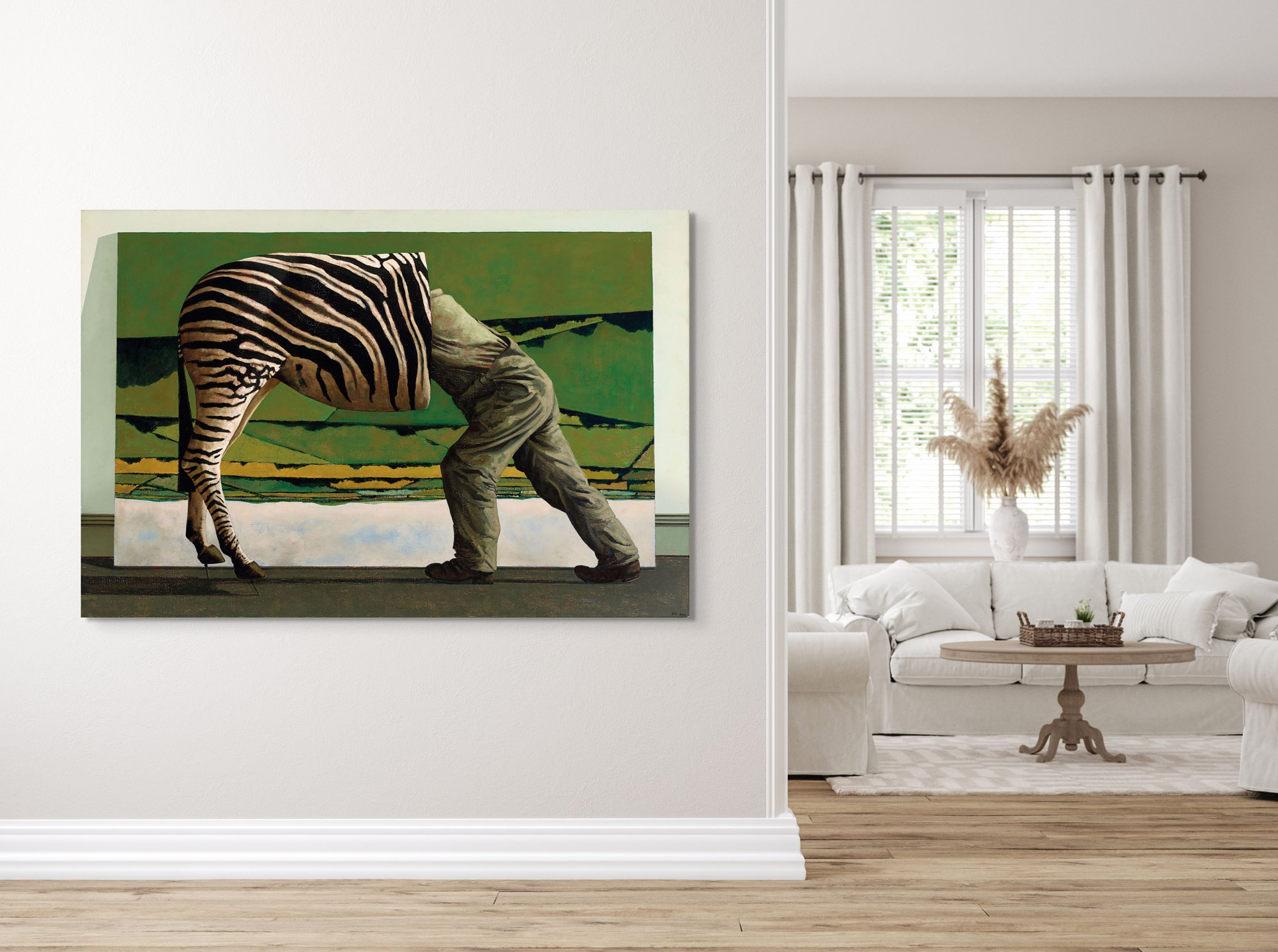JOHN KELLY born 1965
Man Looking into a Zebra 2000
Estimate: $90000 - 120000
Sold For:
$75000 hammer
$92045 inc. buyer's premium
Description
JOHN KELLY born 1965
Man Looking into a Zebra 2000
oil on linen
121.5 x 183.0 cm
signed and dated lower right: Klly [sic] 2000
Provenance:
Galerie Arts d'Australie, Paris, 2000
Private collection, Paris
Exhibited:
John Kelly: New Paintings and Sculpture, The Piccadilly Gallery, London, 4-27 October 2000, cat.3 (illus. exhibition catalogue and invitation)
Related Works:
English Painting 2000, oil on linen, 122.0 x 182.5 cm, private collection; exhibited in John Kelly: More Fucking Cows!, Niagara Galleries, Melbourne, 31 October - 25 November 2000, cat.5
Estimate: $90000 - 120000
Result Hammer: $75000
John Kelly is best known for his blocky, black and white cows, most iconically depicted upside down in a tree. His inspiration for this original series derived from the peculiar moment in Australian military history when artist Sir William Dobell (1899-1970) was commissioned during World War II to create life-sized papier-mâché cows to disguise RAAF bases as farmland from Japanese bombers. Referred to as Dobell’s cows, audiences have now come to know them as Kelly’s cows.
After the original series in the mid-90s, Kelly burst onto the international art scene when his bronze sculpture, Cow Up a Tree 1999 was selected to be included in Champs de la Sculpture 2000. The exhibition held in Paris on the Champs-Elysées celebrated the end of the millennium by bringing together fifty sculptures, including some of the twentieth century’s artistic behemoths such as Pablo Picasso (1881-1973) and Alexander Calder (1898-1976). Kelly was the only Australian invited to participate in this prestigious exhibition, and his sculpture received much media attention for its idiosyncratic humour. An expansion on his earlier Dobell’s cows paintings, the sculpture was based on imagery of flooding which caused the papier-mâché cows to end up stuck in the high branches of gum trees. The celebrated sculpture can now be found in Melbourne’s Docklands precinct.
The humour and irresistible bizarreness in Kelly’s works are not born out of studying surrealist art but from following his artistic instincts. As Kelly states:
My intention is to create work that encapsulated the concepts and ideas that intrigue me. I take historical subjects such as Dobell’s cows… and my own personal experience to build a framework within which I can create my own vision of things. Within this I pursue multi-layered research of concepts and ideas both visual and intellectual… I like to create works that reach beyond their absurdity to reflect something of my visual and intellectual environment.1
Kelly moved from cows to other animals, including horses and indeed zebras, always depicting them with his characteristic absurdist angle. One horse in particular captured his imagination: Australia’s beloved Phar Lap, whose taxidermied form resides in the Melbourne Museum. Paintings such as First Past the Post-Modern 1998 and If You Cloned Five Phar Laps – Who Would Win? 2000 (Figure 2) depict the champion racehorse in various incarnations: skinned, covered with a sheet, cut in half and hollowed – all derived from the experience of viewing the preserved hide at the museum as a child (an experience most Melbournians can recall).
Man Looking into a Zebra 2000 continues this theme, the stiped body cleanly severed down the middle as a man in overalls examines its inside, his legs mirroring the zebra’s hindquarters. As with Kelly’s cows, the horses and zebras are portrayed not as living beasts, but as lifeless props. As we see here, the zebra’s back hooves are propped up on spikes, ready to be installed in a zoological exhibit, on a stage set, or in an art gallery’s exhibition. Presumably the animal’s other half, which we see in English Painting (2) 2000 (Figure 1), is just out of frame, and will be reattached momentarily.
To further this notion that the half-zebra is a prop of sorts, the form is depicted in front of an upside-down landscape painting leaning against a wall, ostensibly waiting to be hung. This ‘picture within a picture’ compositional device is one we see repeated throughout Kelly’s oeuvre and is used to extend the pictorial space. It pays homage to the historical trompe l'oeil effect - the optical illusion of three-dimensional space on a two-dimensional surface, similar to forced perspective in architecture. The landscape painting almost reaches the edges of our canvas, creating a green and grey frame from the surrounding wall and floor. On closer inspection viewers notice the skirting board, the shadow to the left, and the fact that the zebra and man’s feet are planted on the floor outside the painting’s borders. It is only then that the upside-down landscape flattens into a separate object within the pictorial plane. It is in this graphic trick that we see Kelly’s genius as an artist, elevating his works from interesting subjects to captivating, multidimensional works of art.
Interestingly, the inverted painting is a patchwork of vibrant green fields beneath a low cloudy sky – a typically English landscape, rather than his usual dry and inhospitable Australian landscapes often depicted behind Phar Lap. Other examples of his zebra paintings are titled English Painting, suggesting these works are an international equivalent to the quintessentially Australian icon of Phar Lap. Indeed, Kelly describes himself as an Australian, English, and Irish artist. He was born in England before his family migrated to Melbourne where he grew up. At the age of thirty-one Kelly moved back to the United Kingdom, and now lives and works in Ireland.
Footnotes
1. John Kelly quoted in John Kelly: Cow Up a Tree, Niagara Galleries, Melbourne, 1999 (exhibition catalogue)
Asta Cameron
Specialists
-

Cameron Menzies, Chairman & Head of Private Sales
cmenzies@menziesartbrands.com
+61 (0) 466 636 142 -

Asta Cameron, Art Specialist
acameron@menziesartbrands.com
+61 (0) 400 914 088 -

Clementine Retallack, Front of House Manager & Associate Art Specialist
cretallack@menziesartbrands.com
+61 (0) 478 493 026
Location
Sale & Exhibition Details
-
Auction
27 March 2024
6:30PM AEDT
1 Darling Street
SOUTH YARRA VIC 3141
artauctions@menziesartbrands.com -
Exhibition
-
Sydney
14-17 March 2024
10:00AM to 5:00PM AEDT
12 Todman Avenue
KENSINGTON NSW 2033
art@menziesartbrands.com -
Melbourne
21-26 March 2024
10:00AM to 5:00PM AEDT
1 Darling Street
SOUTH YARRA VIC 3141
artauctions@menziesartbrands.com
-


